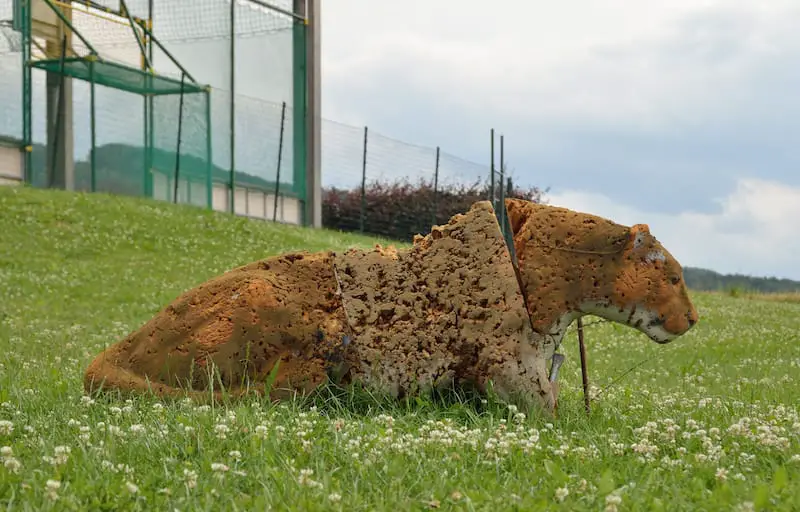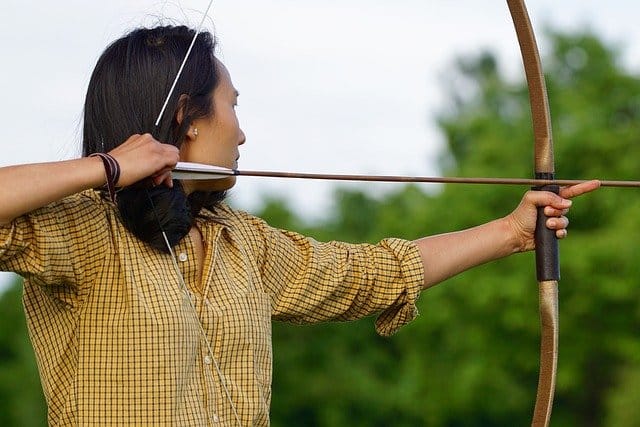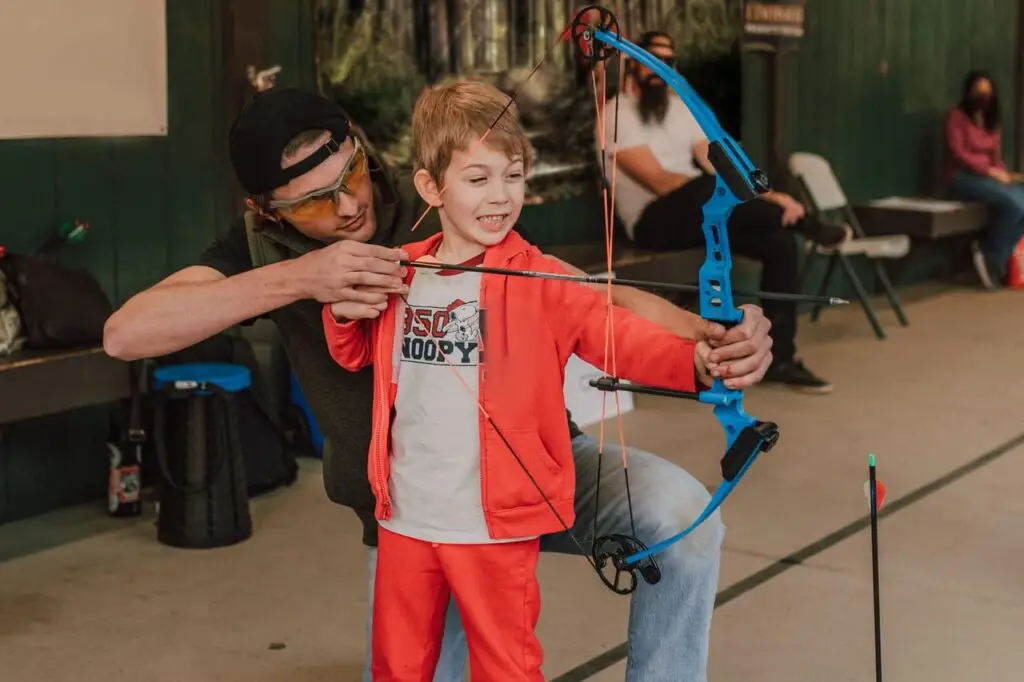From bears to deer to antelopes and more, 3D targets are one of the best practicing tools for any hunter with a bow. They help you visualize the vitals on your animal of choice so you can ensure a clean and humane kill while also providing an easy practice outlet that won’t damage your arrows. However, at $50-$200 apiece, these model targets are pricy to replace, despite how easily your practice shots can damage them. Thankfully, there are numerous ways you can repair damaged 3D archery targets.
The best way to repair a damaged 3D archery target is to fill in the damaged area with a foam of your choice. You can either fill in small holes in the target to prevent the area from expanding, or you can create a foam mold and replace entire sections, particularly the kill or vitals area. The products and method you choose will depend on how extensive the damage is.
If you’re intent on saving yourself some extra by repairing your 3D archery targets rather than replacing them, then you’ve come to the right place. In this article, we’ll discuss the best methods and products for this process, along with answering archers’ most frequently asked questions.

Best Methods for Repairing Damaged 3D Archery Targets
Having a beaten-up 3D archery target that is increasingly shredding and falling to pieces can be a huge nuisance. Not only is it frustrating to see your pricy archery tool disintegrate with every shot, but you might find your arrows are constantly bouncing off the target or fail to land accurately if the target is damaged enough.
While purchasing a brand-new target is certainly an option, we understand your reluctance to spend big money on these tools when all you need to do is fix a small section or two. That’s why we’re here.
When it comes to repairing damaged 3D archery targets, hunters and archers will typically use one of three methods:
- The patch-up
- The block mold
- The glue fill
Each of these approaches can provide a long-lasting fix to your damaged target. However, you’ll have to assess how extensively your target is damaged to choose the method that will repair it best.
Patch-Up Method
The patch-up method is a classic approach that arguably most archers use to fill in small sections of their damaged 3D target. If you assess your target and notice that there are various pockets of damage around the target that aren’t too large or deep, this is going to be the best method for you to use.
The steps and tools you’ll need to pull off this repair method are fairly simple. All you really need is some tape (painter’s tape or duct tape work best), a knife or scissors, sandpaper, and a can or two of expandable or 3D target foam.
To start, wrap your tape of choice around your target, so it covers the damaged area(s) as well as some of the target immediately surrounding it (this provides additional support). You’ll want the tape to be firm, so wrap your target in at least 3-5 layers, depending on the sturdiness and thickness of your tape.
Once your target is all taped up, cut a few small holes in the tape near the damaged areas. You’ll only need about one or two per damaged section since you want the tape to hold its shape when you spray the foam inside.
With the nozzle intact, spray your expanding or 3D foam of choice into the holes you created in the tape. You’ll want to be conscious of how much foam you’re spraying into the damaged areas, as expanding foam will expand over time and might expand out of the damaged area if you’ve used too much.
Allow your foam to set and dry over the course of several hours in a warm and dry setting. After it has dried completely, remove the tape covering the target and use your sandpaper to sand down the foam until it is flush with the rest of the target. If you want, you can purchase spray paint that matches your target’s color and spray the foam for a more cohesive look.
Read this article if you want to make a new DIY foam target in a few easy steps.
Or this article if you want to find out which materials make the best archery target.
Block Mold Method
Sometimes, there are sections of your 3D archery target that are so extensively damaged that it would take several cans of foam to repair it. This usually happens in the kill or vital area of the target, where the archers are aiming for a clean and humane kill. While it’s definitely a source of pride to see that you shoot so well, this area is now in pieces, a damaged vital piece is going to make future practice sessions difficult.
Rather than spray tons of expanding foam into this area to patch up various sections, archers will opt to replace or fill it completely using the block mold method.
There are two ways you can do this. You can hallow out the vitals piece you already have, or you can create a brand new one.
Hollowing the Vitals Piece
The first step of this approach is to remove the vital section from your 3D archery target and hollow it out from one vital target section to the other (it should look something like a hollowed log). Note that if the majority of your piece’s damage isn’t in the center, you might want to opt for the next approach.
After you’ve hallowed out the piece, wrap it completely in a plastic film. Alternatively, you could use tape like you would in the patch-up method. Wrap the vital piece completely until it is firm and add ample pressure to the target piece without inhibiting the foam’s ability to expand inside.
Next, stand the vitals piece upright with one hallowed out end facing up. Cut into the plastic film or tape and fill in the vital piece using the foam of your choice. Remember to leave space for your foam to expand if necessary. Once it’s completely filled, leave your vital piece to dry for several hours before you remove the plastic film or tape and sand down any excess.
Read: Can you use a range finder in 3D archery?
Creating a Brand New Vital Piece
If you can’t be bothered with hollowing out your old and severely damaged vitals piece, you can just jump straight to creating a new one.
The best way we’ve found to do this is to measure the circumference of your target’s vital area and then purchase a brown paper or cardboard tube that matches this circumference. You’ll then cut the tube, so it matches the length of the vital piece through the target.
Once you’ve done all of this, wrap the tube in your classic plastic film or tape. Since the foam will already be encased in the cardboard tube, you can opt to just cover the ends. After everything is secure, poke holes into one end of the tube and fill it in completely with your foam of choice and let the foam dry.
The next step after the foam has dried completely is to cut away that tape or film and the cardboard tube. You should be left with a large piece of sturdy foam you can insert back into your 3D target for further shooting.
If your target’s vital section is more curved or ovular rather than circular, you might have to trace the shape of the opening onto your foam and cut away at the foam until it fits perfectly into the target.
Glue Fill Method
A great way to make sure you don’t have to use any of these more extensive repair methods is to be proactive with repairing any deep damage you inflict on your 3D archery target.
It’s no secret that the more power you put into your shot, the deeper your arrow is likely to burry into your 3D archery target. This is usually the beginning of the large pockets of damage you see on most targets.
Thankfully, some smart archers have discovered that they can limit the spread of this damage by filling in these deep holes using Liquid Nails or Gorilla Glue. Once dried, these glues are strong enough to completely fill any hole your arrow created without posing any risk of damaging your ammo during future practice shots.
What Foam is Best to Repair Damaged 3D Archery Targets?
There you have it; the best methods for repairing any damaged 3D archery target. However, you probably noticed that the integral component to each of these tutorials is some type of foam you’ll need to adhere to the target and fill in any gaps or create an entirely new piece.
If you’re not familiar with foams, you might be at a loss as to which you’ll need to buy for your 3D archery repairs. Don’t worry; we’ve got you covered.
The best foams to use for repairing damaged 3D archery targets are either an expandable foam, a 3D target-specific foam, or Flex-Foam.
Each of these options is guaranteed to provide additional support and mass to your 3D archery target without posing a risk of damaging your arrows. Expandable foams are usually the cheapest option and the easiest to acquire in smaller amounts (ex., one spray can).
You can also acquire a spray foam that is created specifically for 3D target repairs. These tend to be a bit pricier than your basic expandable foam, but they are often much stronger, resulting in increased longevity.
If you have a substantial amount of damage on your 3D archery target and don’t mind spending a little more on foam, we highly recommend purchasing a Flex Foam kit like Flex-Foam-iT 15. You’ll receive three bottles, a Part A and two Part B’s, that you shake and mix together to create the ideal foam filling liquid.
Perks of using this product is that it creates a foam with integrity that exceeds the original material’s, guaranteeing your repaired section will outlast any target foam around it. The foam will also match the color of your target almost perfectly, so you won’t have to deal with the hassle of spray painting your white expanding foam to look less conspicuous.
The downside of this kit is that it costs around $50, which is only about $20 than the cheapest 3D archery replacement, so you’ll want to heavily weigh if this cost is worthwhile.
Can You Replace Parts of 3D Archery Targets?
After reading this guide on how to repair your 3D archery target, you might be telling yourself that you simply don’t have the time or energy to go through the hassle of each of the methods listed above entail, and we completely understand this. Luckily, there is an alternative.
Many companies recognize that 3D archery targets experience a significant amount of damage while the archer is practicing. To compensate for this, they will offer inserts you can purchase to replace sections of the target without going through the hassle of purchasing a completely new target or bothering with repairs.
While the repair options we’ve discussed here are fantastic for damaged 3D archery targets, sometimes the damage is just too great, or the process of the repairs would take longer than is realistic. If that’s the case, there are a number of companies that sell replacement vital areas you can purchase for usually around $20-$50.
Some larger vital areas will cost closer to $100, especially if they’re for a more unique target animal, like a wolf or a wild boar.
These cores will have the exact same integrity as your original target, and all you have to do is pop out the old one and insert the new one.
Final Thoughts
A damaged 3D archery target doesn’t have to leave you running for a new one. It is possible to salvage and restore your trusty target while saving ample amounts of money using the methods we’ve listed here. Apart from choosing the right repair method, the most important factors to consider are what type of foam you want to use and how much effort you’re willing to put into this process.
While we always recommend going the DIY repair route when you can, remember that you can opt to purchase a replacement vitals section as well instead of a brand-new target.


